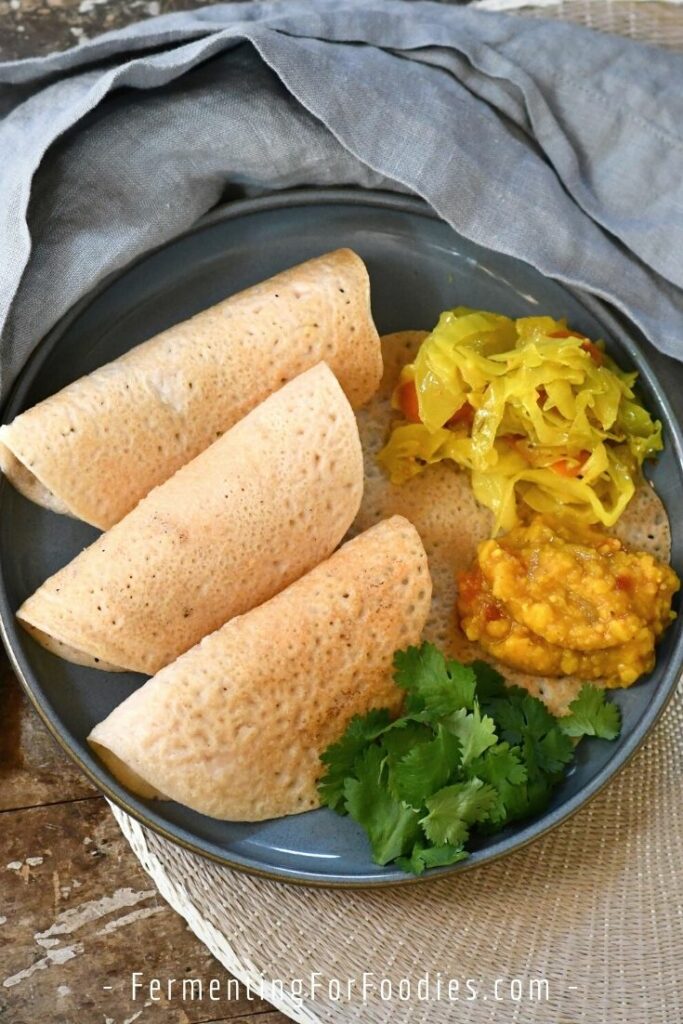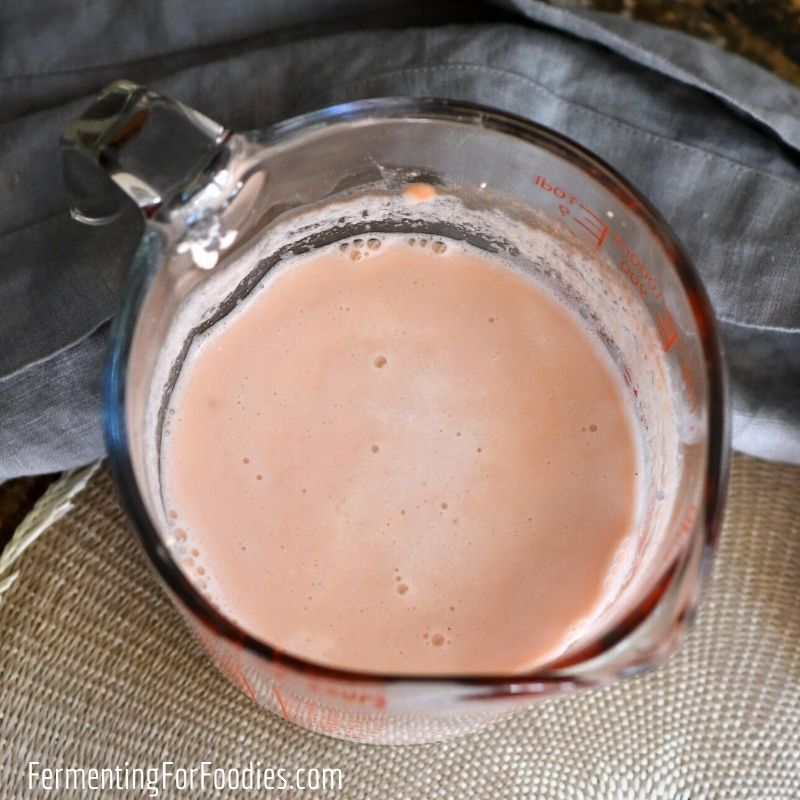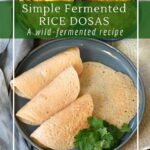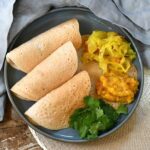Rice dosa is an Indian-style fermented crepe. It is typically eaten at breakfast or as street food, stuffed with a spicy filling. Traditionally gluten-free and vegan, rice dosas have a wonderful sourdough-like flavor.

Fermentation
Rice dosa batter naturally ferments really quickly. It usually takes less than 48 hours to turn into a bubbly batter.
The addition of fenugreek is meant to spur on the fermentation. So it is frequently added to Indian fermented batters, like dosa and idli.
In case you’ve never cooked with fenugreek before, I recommend buying it pre-ground. It is an extremely hard seed, and I’ve broken several spice grinders trying to grind my own!

Dosa Fillings
Dosas are one of my favorite weeknight meals. Most of the work is done ahead of time, so all I have to do is cook a few rice dosa and serve them with whatever I happen to have in the fridge. We enjoy dosas with both traditional Indian dosa fillings and Western savory crepe fillings.
Traditional Indian Fillings
Traditionally rice dosa is served for breakfast or as street food. It’s perfect for holding a flavor-packed filling.
Western Crepe Fillings
Rice dosas are very similar in flavor to a French buckwheat crepe. They both have the same rich sourdough flavor that comes with fermentation. Feel free to fill your dosas with cheese, eggs, hummus, or other non-traditional flavors.
- Hummus, avocado, and fresh greens
- Tomato with mozzarella and basil
- Scrambled eggs
- Wilted greens and cheese
Fermented Rice Dosa
Dosas are a traditional Indian fermented crepe. This rice dosa recipe is naturally gluten-free and vegan. The batter only takes about 24 hours to naturally ferment! It has a rich, sour flavor that is delicious hot, and fresh from the pan. See the section above for filling options.
- Prep Time: 20 minutes
- Cook Time: 15 minutes
- Total Time: 35 minutes
- Yield: 8 dosas 1x
- Category: Main Dish
- Method: Fermented
- Cuisine: Indian
- Diet: Gluten Free
Ingredients
- 1 cup white short-grained rice (see notes)
- 1/3 cup urad dal (or split red lentils)
- Filtered water (chlorine-free for soaking and fermenting)
- 1/8 tsp of ground fenugreek
- 1/2 tsp salt
Instructions
Fermenting
- The rice and the dal need to soak individually for 3 to 6 hours. So place each of them in separate bowls and cover with water.
- After soaking, drain the water from the lentils, and scrape into a blender. Use a few tablespoons of water to rinse any remaining lentils from the bowl and add them to the blender. Grind until smooth and frothy.
- When the lentils are fully ground, drain the rice and add it to the blender as well. Continue grinding until it comes together in a smooth batter. Feel free to add a few more tablespoons of water, if necessary, to help with grinding.
- Scrape the ground dal and rice into a large glass bowl or measuring cup for fermenting. You can use a bit more filtered water to get any remaining ground rice and dal from the bottom of the blender. The batter needs to be 2 1/2 cups in total volume, so add more filtered water if necessary.
- Stir in the fenugreek. Cover the container with a tea towel and leave it somewhere warm to ferment for at least 12 hours or up to 48 hours. Give it a good stir with a fork about twice a day. The dosa batter is officially ready when it is nice and bubbly, but you can be flexible to fit your schedule. The longer it ferments the sourer it will be, so don’t let it go much more than 48 hours.
Cooking
- When you’re ready to cook the dosas, heat a frying pan on medium. I use a cast-iron pan, but any non-stick pan will work.
- Add the salt to the dosa batter and stir gently to keep the frothiness. The final batter should have a thick, pourable consistency, so add a bit more water if necessary.
- Brush on a thin layer of oil in your pan. Then ladle 1/4 cup of batter into the pan and spread it around with the back of a spoon to make a thin layer.
- The dosa is cooked when the bottom side has started to brown and the top side is dry. You can either serve it like this or flip the dosa over to lightly toast the other side. You want the dosa to be fully cooked, but still soft enough to fold and roll.
- Serve fresh and hot with your choice of fillings.
Notes
- If rice isn’t your thing, try my millet and red lentil dosa recipe instead!
- The amount of time it will take your dosa batter to ferment depends on the temperature and local strains of yeast. Unlike bread, a precise doubling of the batter isn’t required, but do expect it to bubble up.
- It can take a bit of practice to make nicely formed dosas. Just make sure that you oil your pan each time as the dosas don’t have any oil and they will seize otherwise.
- Short-grain rice is better than long-grain because of its starchiness, however, idli rice
(if you can find it) is the best rice to use.
Nutrition
- Serving Size: 1 dosa
- Calories: 113
- Sugar: 0.2g
- Sodium: 149mg
- Fat: 0.2g
- Saturated Fat: 0.1g
- Carbohydrates: 23.3g
- Fiber: 2.7g
- Protein: 3.7g
- Cholesterol: 0mg



Can you use brown rice instead of white rice? That’s because white rice is not healthy. Thanks!
In fact, brown rice is more unhealthy than white rice. We now know that rice contains a fair amount of arsenic from the pesticides that are used to grow rice. It’s quite concentrated on the outside (which brown rice retains) so when the outside is removed, there is less arsenic though still quite a bit in the white interior. Eating brown rice means you are consuming much more arsenic. On top of that, if you follow Dr Steven Gundry, you learn also that there are plenty of lectins and phytates in the germ and bran which bind to the vitamins and minerals in the food you eat so they cannot be abosorbed by your body. They are known as anti-nutrients. The same goes for whole wheat flour vs white flour. So if you really must be flour or rice, opt for the white version and get your vitamins and minerals from another source.
Greetings,
Yes, you’re absolutely right! Brown rice is more unhealthy than white
It was mentioned to substitute millet for the rice Great idea!
Hi CC, I pre-soak because it makes the grinding easier and smoother. But you can definitely do it without if you want. 🙂 We serve our dosa with whatever happens to be in our fridge. Millet is a good alternative to rice. I use this recipe for millet dosa: https://www.fermentingforfoodies.com/lentil-and-millet-dosas/ It’s pretty similar to the rice recipe. Enjoy!
White rice isn’t very healthy–as there’s no fiber in it, nor nutrients. With that, would brown rice work instead? Let me know.. Thanks!
Yes! Feel free to use brown rice instead of white rice. It just might take a bit longer to grind, but it will still ferment.
Hey hello,
could someone let me know how many dosas this recipe makes?
thanks already
It depends on how large your dosas are, but it should make around 8 dosas. Enjoy!
Hello Emillie,
Is it possible to use white rice flour and bean flour (instead of urad dal) and fement the flour and proceed with the recipe from that point on? Do you think that would yield similar results?
Thank you.
Yes! It should work fine. The only difference from traditional dosas is that the batter will be quite smooth. Home ground dosas have more of a gritty texture which is actually quite nice. Cheers, Emillie
Can these be used as tortillas?
They aren’t the same texture as tortillas, but if you aren’t able to tolerate corn, then they are a good alternative! A bit crispier and more breakable than corn tortillas. But otherwise, delicious. Enjoy!
I found ground idli rice at my local Asia Mart. Since that can’t be soaked then strained without everything falling through the strainer, can it be used either unsoaked or with the soaking water, in which case, how much water would you add, and how late Ng if at all would you soak it? Thanks 🙂
I have never used idli rice… so I’m not entirely certain. In this recipe, you still want to soak and ferment the rice. However, you don’t need to pre-soak for grinding. Add enough water to make the 3 cups of total batter. You may need to add a bit more water when cooking, but it will depend on how much liquid the rice absorbs. Enjoy!
I wondered why the pre-soaking! I’ve tried other similar recipes and they worked fine without that! Getting it smoothly blended and fermented is the most important! Saves time, too!
What dips or sauces do you serve yours with! My DIL who moved here with my son 6 months ago has mentioned missing this the most! She loves my cooking, does NOT like to cook! Has her peppers and spices to add to any Canadian food! ALSO, I LOVE to cook, so I do it for them every week
Oh sorry! It should say my DIL from India
Delicious! Thanks for the recipe.
I live at 3,400 ft., I fermented the mixture for 72hrs. on my counter covered by a cheese cloth. The mixture is thick, but there was a little dark yellow coloring on the top. Is that okay? Is there a point of over fermenting? I’ve made this years before, and have always used brown rice but this time I used white basmati.
Hi Yvonne, Sorry for the slow reply, for some reason your comment was in my spam folder (?) Anyhow, you can over ferment, but that’s more about flavor than anything else. If you find the dosa too sour, then simply ferment for a shorter period the next time. I’m not sure what the darker coloring is… but maybe it just came from the lentils or fenugreek? If it wasn’t mold, then it’s fine. Cheers, Emillie